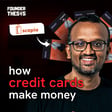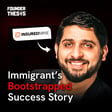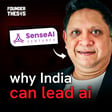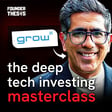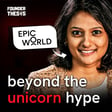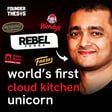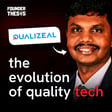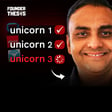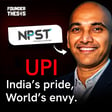Introduction to the Founder Thesis Podcast
00:00:01
Speaker
Take a minute, I'm dead, you know what I'm talking about. This is Aurabh, and you are listening to the Founder Thesis Podcast. We meet some of the most celebrated sort of founders in the country. And we want to learn how to build a unicorn.
00:00:27
Speaker
Hi, I'm Aditya, I'm the founder and CEO of Niro.
Bundling and Unbundling in Internet Businesses
00:00:31
Speaker
It's a well-known maxim in internet businesses that everything is bundling and unbundling. What does this mean? Let me explain with an example. The traditional way in which music was distributed was as a bundle. A CD or a cassette tape had a bundle of songs in it and that was incredibly profitable way and led to large music businesses getting established.
00:00:57
Speaker
And then it got unbundled by the MP3 and Apple Music became a large business because it was selling you individual MP3s way back in early 2000s. And this again got bundled via Spotify. Spotify was selling you a bundle where you could consume all you can eat music with a fixed monthly subscription. And this has been the story of multiple industries and this is pretty much what's happening in the lending space.
Niro's Lending Infrastructure through API
00:01:26
Speaker
You had these traditional companies like say a bank which was a bundle it would do everything from drawing in supply of funds through savings account to finding people who needed funds by offering loans and this is now got unbundled where there are fintech companies who are just doing lending and they are being supplied funds by banks who are soaking in the savings.
00:01:50
Speaker
This is further getting unbundled through businesses that are building pipes. And a perfect example for that is Nero. Nero is building the pipes that allow anybody to start lending just through a simple API integration. Think of Nero as a payment gateway accept.
00:02:09
Speaker
what you are integrating into your product now is lending. Niro takes care of everything on the backend, be it KYC, be it risk underwriting, be it the tie-ups with the banks and NBFCs who actually do the lending. You can just focus on the customer experience.
Aditya's Entrepreneurial Journey
00:02:27
Speaker
Aditya, the founder of Nero, has had a fascinating journey himself. He grew up in the West, came back to India to become a founder, and he sold his first venture, which was a lending business, to Incred. And now he's building the pipes to help other businesses get into lending. Here's Aditya talking about his journey and how the idea of Nero came to him.
00:02:56
Speaker
If you like to hear stories of founders then we have tons of great stories from entrepreneurs who have built billion dollar businesses. Just search for the founder thesis podcast on any audio streaming app like Spotify, Ghana, Apple Podcasts and subscribe to the show.
Challenges in Retail Unsecured Credit
00:03:18
Speaker
What I had discovered in this process was that at the end of the day, when it came to retail unsecured credit, which is people like you and me looking to borrow against, let's say, our salary or any other stream of income that we may have, that market was very, very concentrated. That was basically still aimed, it was a large market, but it was still aimed at people who earn more than six lakhs a year.
00:03:42
Speaker
people who worked at the top, at that time, top 30,000, 40,000 employers in the country, and people who had super prime credit histories. So that's obviously in terms of the overall distribution of the working population, that's a tiny segment, at least in terms of absolute numbers. Their propensity to borrow is obviously the largest, but the segment itself is tiny.
00:04:09
Speaker
And so then took it one level deeper and I said, why is this the case? And the bottom line is that banks especially don't have either the distribution.
00:04:20
Speaker
or the risk appetite, or the technology to be able to lend to the long tail of customers. And by long tail, actually not even the long tail, I would say the middle tail, on a normal distribution curve banks and lend at that top 2%. You've then got this entire 2 to 30%, which is a huge market, which is people who earn between 2 and 6 lakhs per annum, people with thin files, no credit histories, or very good credit histories, and people who work for over
00:04:50
Speaker
10 lakh incorporated entities in India that are active with regular incomes who have stable jobs, who need 50,000 a lakh, 2 lakh, 3 lakh rupees for any purpose.
Early Challenges and Partnerships
00:05:05
Speaker
And so because they don't have distribution in those segments, because they don't have the risk appetite to underwrite those segments, and because the unit economics don't make sense because they can't leverage technology and it's all branch based,
00:05:17
Speaker
there was a huge opportunity in that segment, right, was the thesis, right? And so, you know, sort of having uncovered this, right, the next question was that, next question was that how can one and how can one go about building a large business around this, right? And so, you know, having done an educational stint and entrepreneurial stint and sort of to that extent comfortable, you know, building from zero to one, right?
00:05:47
Speaker
The credit game is one that if you do a little bit of research around, you can build a certain amount of confidence in terms of understanding the different levers of the business in terms of what will help make money and what won't. But the bottom line was, hey, can we give this a shot?
00:06:03
Speaker
So we actually managed to raise, you know, spoke to friends and family, a couple of smaller angel investors managed to raise like a three crore angel, like a seed round, just to get get things off the ground. We actually also ran in while I was in the US, studying this entire FinTech B2P space, ran into a technology company called Sigma info solutions that offered to partner with us and provide the entire technology to us. So that was another big, big
00:06:31
Speaker
What was the technology play here? Like the underwriting would happen through that? So everything. So the acquisition, the underwriting and the entire management and the processing of the entire customer and the loan book, everything would happen on a tech platform.
00:06:45
Speaker
So when we met these guys, it was because they had some very, very large clients in the US using their technology. Obviously, that was a big part of the battle one, because we felt like, hey, this is something that we don't need to build from the ground up all over again. So today also, if you're going to use a CRM, you'll go to lead squared, you'll go to Salesforce, and you won't sit and build a CRM in your internally. So that was kind of the thesis at that time, though that part of the thesis I would say didn't work out quite as planned.
00:07:09
Speaker
And after raising half a million from largely friends and family, you know, sort of started building a small team out, found some great guys early on that were willing to jump on board and, you know, get started. But I think the biggest breakthrough that we had after putting the team and a tiny bit of capital together was we were fortunate to meet someone who becomes sort of an advisor and consultant to us, who introduced us to RBL Night.
00:07:37
Speaker
So, the demand side of the thesis was still clear in terms of who we wanted to rent to, what was not clear is, where is the money going to come from? Should it be P2P and retail investors? Should it be our own balance sheet where we actually put up equity and then raise debt and lend from our balance sheet? And what this allowed us to do is actually get fun access to institutional capital at institutional rates.
00:07:58
Speaker
without compromising on the segment that we wanted to link to after customer experience, technology, et cetera. And that was a huge vote of confidence. A couple of months after having incorporated, when RBL actually came to offices, met the entire team and said, you know what, we'll give you our management.
Partnership with RBL: Risk and Revenue Sharing
00:08:15
Speaker
And then the question was that today, if you do it yourself, you have a crazy cost of funds. If you have to aggregate retail demand, the regulatory uncertainty around it and be expensive, because now you have to find a customer and that's acquisition cost there. And you have to find a supplier of capital. So the acquisition cost there. And so when that happened, I think we incorporated in
00:08:41
Speaker
at the beginning of 2016. And at the beginning of 2017, we went live with RBL. And we did 15 lakh rupees of loans in our first month, I think. 40 lakhs in the second month, then slowly, slowly, slowly do that business, kept and raised smaller rounds of, again, additional angel capital.
00:09:03
Speaker
What was your deal with RBL? You would be like a DSA for them, the way they have DSAs who do loan origination. No. So the deal with them is that we would actually share risk with them and revenue with them.
00:09:17
Speaker
So, we would actually acquire the customer, we would underwrite the risk on an agreed policy, we would do verification KYC, and we would actually manage the disbursement. And we would take the first X percent of... If there's an NBIR. If there's an NBIR. So, let's say three, four, five percent of first-loss, what we call FLDG, which is a first-loss default guarantee. The first three, four, five percent of principal loss would be borne by us. So, if we gave out 100 rupees on a two-year loan,
00:09:46
Speaker
The first five rupees that went in would be to ARCA. First five rupees to that one customer or first five rupees of the entire portfolio? At an aggregated level of the entire pool.
Collection Processes and Partner Dynamics
00:10:01
Speaker
It adds up to the same thing. But in exchange for that, ARVN would keep sort of a 15-16%
00:10:07
Speaker
return. So let's say the loan was priced at 23. And we would actually keep the spread in the middle. So if we price loan at 23 and RBL was charging at 16, we would keep 7% per annum.
00:10:20
Speaker
right in the middle. So on a two year loan that works out to almost 10 on a reducing balance that works out to almost 10, 10 and a half 11% actually on a three year product, right? We had a roughly five, five and a half percent spread per year, right? So even if we give them 4% first loss, if we were making 11, 11 and a half percent over three years, right, we were making 7% on the loan and it was a two lakh loan.
00:10:42
Speaker
which means net of first-class, we were earning, you know, on a, we were earning 14, 14 and a half thousand rupees in net of first-class, right? And it was, you know, people would think that why would the bank do this really not directly for the reasons I mentioned. They don't have distribution. They don't understand the risk and the unit costs because it's only a two-lack loan, don't make sense to them because their cost structure is much better, right?
00:11:03
Speaker
So, they are walking away with 15-16% with no acquisition cost, with no operating expense. With the cost of funds of maybe 7-8%. So, they're making 7% spread, risk-free, super happy. And we're making 7% taking some risk, risk-free 7%. We're super happy. And who would do collections? So, it was interesting. Interesting you asked that, Akshay. It was actually, when we started out, it was actually the bank entirely.
00:11:31
Speaker
So it was very interesting because this dynamic between the collection agents for their portfolio and our portfolio is the same guy. Our loans are obviously smaller ticket size. So what would happen is they would, at the beginning of the month when a collection agent gets their entire inventory to collect, they sorted by ticket size.
00:11:52
Speaker
Right because you want to go after the big fish first, right? So invariably our loans would be collected last and then they would roll over into the next what we call bucket of collections, right? So eventually we started hiring a few guys on roads, right? But RBL was only the first lender and we managed to make it work really well with them despite the world believing that there would be a huge conflict of interest, right?
00:12:14
Speaker
With Indesign, who is actually our second partner, the collection efficiency was incredible because the guy, the business head at Indesign, the person who runs the P&L is actually responsible for both sales and collections. So he's very highly motivated to ensure that whatever gets originated gets connected as well.
Shift to Omni-Channel Customer Acquisition
00:12:32
Speaker
And we had the same experience with Fullerton, who became our third lending partner. So I think we actually managed to make that part of the equation work. Having said that, in my present Aftar, we're actually building an entire collections capability from the ground up. And what was supposed to be the way for repayment of loan? Was it a one-time mandate that they would sign, or what was it like?
00:12:57
Speaker
It was a natch mandate. Every month we pull money out of their account. If his or her natch mandate, if their natch instrument bounced any month because there was insufficient funds in the account or because the account had been closed, then the account would go to collections. For soft collections, which means you get a call, you get an estimate, you get an email, you get a WhatsApp. And if we're not able to resolve the overdue payments of that, then it goes to field. Field in Kubera's case back in the day was bags field.
00:13:26
Speaker
Right, right, right. Okay. What was the way you acquired customers here? Like how the people who want loans? So we were on the channel, we started out, we started out digital only, right? And at that time in 2007.
00:13:41
Speaker
Like you were doing like Facebook ads. Facebook, Google, organic, organic, you know, publish content, get backlinks, try and drive traffic organically. And that actually worked really well for about a year and a half, actually two years, right? So 2017, it worked really well. 2018, it worked really well for two reasons. One is that, I mean, actually one reason. The only reason was that fundamentally there was more demand going online than there was supply, right?
00:14:09
Speaker
What happened at the end of 2018, when we actually flipped over to doing a lot of offline stuff as well, going to agents, going to aggregators, et cetera, was that the competitive dynamics of advertising online changed. So you had this massive surge of digital lenders that were now coming to the same places, Facebook.
00:14:31
Speaker
Google, Instagram, LinkedIn, et cetera, to find that. And there is a finite pool of borrowers that isn't growing that quickly. And so because most of these platforms work on a bidding algorithm, the effective cost per lead started skyrocketing and the quality of the average borrower started deteriorating.
00:14:50
Speaker
So that became a deadly combination by December 2018, we were sort of struggling online only, because the minute you try and absorb more than a certain impression share, right on Google or Facebook, the cost starts going up disproportionately. So if you want to see if you want customers, 2% of all customers that are searching for personal loans to see our ad, the cost per click could be something like 40 rupees. But if you want people to see if you want 20% of customers,
00:15:18
Speaker
who are searching for personal loans to see our ad, the cost per click can go as high as 200 rupees. So then we started omni-channel at the end of 2018. There's a colleague of mine from Sybil, Alok, who's now at Trusting Social, who had been working with us for two years. Alok came and joined us to build the entire offline sales capability.
00:15:41
Speaker
At this point, there's a capital story also which happened at the same time. After raising multiple small rounds of capital, we actually went out and tried to reach out to a bunch of venture capital funds and tried to raise a so-called series A at the time.
00:16:06
Speaker
How much had you raised by that time, like the pre-series A total? We raised about a million by then. So about six, six and a half crores roughly at that time from a bunch of small angel investors. At that time, the challenge that we found when we hit the market for series A was largely twofold.
Series A Funding Challenges
00:16:27
Speaker
our technology was viewed as being outsourced because we had this tech partner that was running it. And so the optics of that, the practical, you know, practically on the ground for us, that wasn't a challenge, but the optics of it were terrible. The second challenge that we had is because we raised so much angel capital and because we have this strategic technology investor.
00:16:46
Speaker
Almost half the capital was owned by non-founders so this sort of made it prohibitive and we were very lucky to find a gentleman who's a part of the ZSL group who runs a company called e-city ventures which used to own fun cinemas and all the fun
00:17:07
Speaker
hundred public malls, who was actually looking to get into the financial services space. So he incubated an NBFC and was looking for a platform play to complement the NBFC play and vice versa. And he actually agreed to invest the 3 million primary that we needed. He also put in $2 million of capital and cleaned up the cap table. So took everyone else on the cap table out, including the technology partner.
00:17:32
Speaker
Thanks to that investment, we were able to go from originating 2 crores a month to almost 12 crores a month in 6 months. Explosive growth. At a unit level, if one factored in the lifetime value of the customer, we were actually making money. Cash burn was obviously higher because we would incur all our expenses upfront, but revenue came in over the 3 years of the loan.
00:17:56
Speaker
The loan was typically a three year loan, like what kind of loans? Three year loan, 2 lakh rupees, 21% interest, 3% processing fee. Okay. It's like a flat single product that you were offering. No, no. So we did everything from loans at 16, 17% which were 5 lakh rupees for five years, to loans which were 27, 28%, 50,000 bucks for one and a half years. We did the entire spectrum.
00:18:24
Speaker
So we post raising capital, it went to, you know, sort of 12 crores a month and by we had like a 40 crore book when the investment came in and now we had a hundred CR plus book.
00:18:36
Speaker
So in the middle of 2019, we decided to go to market and try and raise a series, what would not be series B equivalent. We met like 40 funds, feedback from everyone was the same that the cap table is just, it was lopsided. We were in minority positions with one large promoter sort of sitting on the cap table. How many founders were there besides you?
00:19:03
Speaker
So I started out as a sole founder, and we named two others founders along the way. Anubhav, who is now the founder of Rupify, an embedded B2B sort of lending startup. Anubhav was named co-founder in 2018. And Anuj, who now runs a company called Gold Setu, was named co-founder in 2019.
00:19:28
Speaker
So feedback at series B was broadly the same, you know, as a great business, unfortunately, you know, uninvestable from a capital perspective. We went to private equity who tend to be slightly less capital sensitive, you know, wasn't any better. It was too small for private equity, actually. And so by October 2019, I started looking at strategic options.
Incred's Acquisition for Digital Capabilities
00:19:52
Speaker
Spoke to a bunch of larger fintechs, spoke to a bunch of NBFCs that didn't have digital capabilities, spoke to some banks. And long story short in that journey, Incred, which is obviously run by Bupinder Singh and a bunch of very senior ex-torture bankers, Bupi liked the story and offered to come in and sort of acquire the business. So Incred was like a more offline type of NBFC or like what was Incred?
00:20:22
Speaker
Incred was sort of a startup at VFC. They had about a 2000 crore book, but they didn't have a digital lending business and they didn't have a platform business where they could work with third-party lenders. So for them, this was an augmentation of, I guess, three things. One is us as a team and leaders. The second was a digital capability. And the third was a platform business where Incred has this ambition to become a FinTech. So it's Incred now working with third-party balance sheets through the Kubera platform.
00:20:52
Speaker
Right, right, right. Okay. And Incred was again B2C, like same audience, like standard class or what were they? No, so Incred did a mix, Incred did education, which is obviously B2C, Incred did PL, which was B2C, Incred did SME, MSME, lending, supply chain financing, lending to schools. They did two wheeler at the time, which they subsequently stopped, right? So it was a mix. It was a, it's a reasonably, I mean, that way a reasonably diversified book.
00:21:19
Speaker
So Incred did an acquisition and you became part of Incred? So Incred, this process took a while. I think by the time everything happened, it was sort of March and then COVID happened. And then for a while, you know, things were in limbo and we actually managed to conclude the deal during the first lockdown. So in April of 2000 and April 2020 was when it concluded.
00:21:45
Speaker
Okay, did COVID impact valuation like I've heard a lot of stories of deal valuations getting changed due to COVID impact? Yeah, it did. It did. It did. And you know, and you can't really blame anyone because things were so uncertain at the time. Nobody knew when this will end when you know, you'll be able to start business again, when you will be able to monetize value out of this etc. So it was a day but fortunately, you know, it went through in April. Otherwise, you know, you would have been in a very, very tough spot.
00:22:13
Speaker
That acquisition, was it like cash plus equity or like what was the terms of the deal? I mean, it was complicated because the thing is it was an asset and so the company stayed with the Australian investor. There was some consideration when there was some equity for those moving.
00:22:28
Speaker
complicated structure. But I think given the circumstances, it was a fair outcome. And obviously very relieved to find an outcome, especially in the middle of the very first lockdown, the amount of uncertainty that clouded, you know, that sort of clouded the entire, clouded with the entire, especially the financial services, with collections being hammered, right, and then moratorium kicking in, and then, you know, it's just one thing after another.
00:22:55
Speaker
Yeah, yeah, yeah. But how much value did you create for yourself over like this three, four year period? So a lot of the value, you know, actually was actually more in the form of equity that would have come in had I stayed at, you know, had I stayed at Incred over the next couple of years. So it was a complicated structure. But
00:23:15
Speaker
Honestly, I mean, that journey, right? And then the beautiful thing that entered for me was that I was given a role to manage the entire consumer P&L there.
Success Levers in Lending
00:23:27
Speaker
So our on-balance sheet business for retail consumers, our partnerships business where we work with other fintechs. So earlier, it was me as the fintech working with an RBL industry in Fullerton.
00:23:38
Speaker
Now, it was me as the balance sheet working with money, tax raise, EBO, lease and retest money, etc. So that 360 degree experience was in the most sincere way, it was really, really incredible. Got to see some scale, got to see real risk management at play.
00:23:56
Speaker
and also build an appreciation for why fintechs exist because there are some things that large balance sheets or even mid-size balance sheets are greater doing. There are some things that fintechs are not greater doing and vice versa. I want to understand more about the credit industry. What are the levers of a credit business or a lending business? What drives success in it?
00:24:20
Speaker
So, there is multiple things and in no particular order, maybe in some particular order. So, I think cost of funds is one.
00:24:29
Speaker
in a lending business because what a cost of funds allows you to do fundamentally is lend at more competitive rates. Lending at more competitive rates invariably attracts a better quality of consumer that nobody else has access to because of your cost of funds advantage and HDFC is the best example of this. HDFC can do a person loan at 10.5% today unsecured and be exceptionally profitable because today probably has a sub 3.5% cost of funds. So I would say the first thing is your cost of funds.
00:24:57
Speaker
And for this cost of funds, I understand for banks, what is cost of funds? The depositors are putting their money in the bank, so that is the funds. But what about for, say, in grid? What is their cost of funds? It's not retail investors. It's corporate borrowers. So you go to other large institutional lenders, and you raise capital from them. These could be public sector banks. These could be private banks. These could be inter-corporate deposits. These could be bonds, et cetera.
00:25:26
Speaker
And what rate do companies like Incred have, like for their cost of funds? I mean, so, NBSC is in general today in India, right, that have a vintage of four, five, six years. In today's interest rate environment are probably sitting at a cost of funds of between nine and 10%, right? The very large ones might be as low as seven and a half, eight.
00:25:46
Speaker
The slightly smaller earlier stage one could be as high as 11, 11 and a half, 12. But in general, that's the in today's interest rate environment, which is obviously historical low, right? It would be in depending on size, scale, quality of book, etc, would be in that zip code.
00:26:04
Speaker
Okay. And for FinTechs, which are in the lending business, like say, lending card, capital float, for them, the funds are through lending partners, like the way you had done. So it's a combination. So in the case of capital float and lending card, they both also have balance sheet businesses, which are NBFCs, right? They're tech led, they're tech first, but they're still NBFCs. So the cost of funds that I wouldn't know what it is today, my guess would be it would be sort of low double digit, right?
00:26:33
Speaker
And then you have guys who are either balance sheets who have a non-balance sheet business, right?
00:26:39
Speaker
which is just a tech platform where you have lenders that you work with, where you do what we call direct origination or on-lending, where you effectively work with a balance sheet to lend off their balance sheet and the money comes back onto their balance sheet. So, guys, like I said, Niro also, where, again, today, cost of funds, because you don't have the regulation cost, that cost tends to be slightly higher, can be in the zip code of 12% to 15% roughly.
00:27:03
Speaker
Okay. Sorry. I interrupted your answer. So the first thing you said is cost of funds. What are the other levers? So first lever is cost of funds. Second lever, which actually determines how your cost of funds is, is your risk management, right? Your ability to control asset quality, your ability to scale without compromising on asset quality, your ability to originate sensibly and to collect, right?
00:27:27
Speaker
For NDFC businesses, this is also typically driven by a credit rating, right? So an e-cra, a crystal, somebody, a Moody's, which will describe a rating to you, and that rating, depending on whether you're triple A, double A, single A, single B, double B, triple B, will then determine what your effective cost of borrowing is, right? It's kind of a rubber stamp, kind of a rubber stamp on how well you manage your business and how well you manage this. That's the second one. The third is distribution, right? And I think this is one which is,
00:27:57
Speaker
This is one which I think a vast majority of NPCs in India have under invested in. And maybe my lens is clouded or is limited to the unsecured retail asset space. I think they've made a lot of strides in other areas like two wheeler financing, commercial vehicles, etc. Less well-versed to those. But when it comes to traditional unsecured lending, retail lending, personal loans, credit lines, that kind of thing, the problem, the challenge that becomes it
Role of Technology in Lending
00:28:25
Speaker
And we haven't been able to build distribution, right? This is why credit can get to a 3000 problem book, which you could take in two years, which would take another and we are C2, three, four years to build in PN. Right. So I'd say distribution is the third lever, both internal cost dynamics selection, right? The kind of use you're able to read.
00:28:43
Speaker
Geographic reach becomes a huge limitation for most mbfc's because they insist on having a branch in every location so then you have five locations ten locations twenty locations fifty locations but that doesn't still doesn't cover a majority of india right. For this topics how can you how can you manage and how can you keep your entire cost of operations.
00:29:05
Speaker
And the fifth is if you're a balance sheet business, obviously, or even a non-balance sheet leverage. So essentially, you've got your acquisition cost dynamics, lifetime value, et cetera. You have your cost of funds. You have your risk management. And you have your entire OPEX infrastructure. Obviously, the one thing that can help, which is kind of a, it's not really a lever, but it's one that underpins all of this now and becomes a foundation, especially for context, which is tech.
00:29:36
Speaker
Tech can help you build defensible distribution, especially in an embedded context. Tech can help you lower your cost of acquisition, help you improve processes, and therefore attract a better quality of consumer. Tech can help you reduce fraud risk. So that's the fifth, but it's not a lever. It's kind of something which, in today's vein, it underpins every single aspect of any business, especially of financial services or of intelligence.
00:30:01
Speaker
You use the word embedded a couple of times. Can you clarify what you mean by that? So embedded essentially is financial services typically tends to be all a standalone experience, right?
What is Embedded Finance?
00:30:16
Speaker
So it's financial services today. I need a loan. I go to my bank. I need a loan. I go to bank bizarre. I need a loan. You know, I call a friend, right? So the entire experience tends to exist in a standalone ecosystem, right?
00:30:30
Speaker
So you can think about it, I think an advertising analogy is a good one. Think of your advertisements that you see on your bus stand. Think about your advertisements that you see on holdings as standalone advertisements and they play a very vital role.
00:30:51
Speaker
Now, think about advertisements inside any mobile application that you use. If you open your Airtel app, you might see an ad. If you open nokri.com, you might see an ad. If you open MDT, I think there is more ad than content. So, I think it's a form of being able to embed certain types of products into experiences that customers are already engaging with and that they love.
00:31:13
Speaker
I think the notion behind embedded, again, this is limited to more credit or even embedded insurance or embedded investments in savings is that you can deliver a financial services experience inside an existing platform, inside an existing service seamlessly, but also leverage data and leverage distribution to make that experience
00:31:40
Speaker
you know, this Frank Rockman says this almost transcendent for the user, right? So typically, you know, if you need to borrow 5,000 rupees and go and pay for something, it's a terrible experience, right? The experience of a lazy payer or a simple offers you on a, you know, on a swiggy or a damzo is almost transcendent, right? Because it's, it's one click, right? It's zero paperwork, pay your bill after 15 days, right? It's, and at no cost to you, right? It's almost too good to be true, right?
00:32:11
Speaker
I think the thesis around this is multifold. One angle of this is that more and more types of financial services will eventually exist within existing platforms, existing services that people are already availing. In some cases, be almost invisible to the consumer or extremely seamless to the consumer.
00:32:34
Speaker
And the second is that therefore, you know, the sort of profit pool in the revenue pool here will start to be owned by companies that have nothing to do with financials.
00:32:43
Speaker
Right. So I want to give some examples here. So like, like, say you have you go to big bazaar and big bazaar is doing a co branded credit card. Is that like that could be embedded finance, right? Like, yeah, completely. So that's one experience gets simple, easy to buy now pay leaders and other experience. Check out financing, which you know, Bajaj finance, this money, etc. Offer is a third where you can buy something on EMI at the click of a button.
00:33:11
Speaker
And then Catabook's business model is this one. You know, like Catabook gives a free software for accounting and their monetization is lending. So that is, again, even credit for that matter. On the MSME side, yeah. So Catabook is on the MSME side. I would say one of credit is lending the other, is even investments. They have this 9% fixed deposit. Well, 9% lending product, investment savings product, which they offer through liquid loans.
00:33:40
Speaker
Absolutely, embedding this, you can have co-branded cards, which is the example that you gave, you can have buy now, pay later, you can have consumer durable or any sort of checkout financing, which is Zest Money, Bajar Finance, etc. You could have integrated, embedded, unsecured credit,
00:33:57
Speaker
Truecaller today offers personal loans, though it's not fully embedded. Truecaller offers personal loans, which are scaling like crazy. You can have embedded insurance where you're taking a trip and make my trip. You just check a box and you get travel insurance embedded into it. You can get health insurance embedded into it. But I think what we'll end up seeing more and more of is also a lot of these are use case driven.
00:34:22
Speaker
So what happens is that today, because I'm buying something, I now require financing for it. And the motive behind that type of embedded lending is to help the customer be more sticky, more loyal, transact more for greater values on the platform. I think what we will start seeing now and what Nero is in the business of building is
00:34:48
Speaker
being able to offer consumers different type of credit products embedded into any mobile application that you have on your smartphone. Where you say, I might need 2,000 rupees of credit to check out somewhere, I might need 10,000 rupees to finance something, but I also might need a lakh, 2 lakh, 3 lakh, 5 lakh, 8 lakh rupees, the way credit offers you on their app, on competitive terms at the click of a button.
00:35:14
Speaker
So embedding credit of all types is something I think we will all see more and more of. And recent Horowitz last January prophesied that every company will soon become a financial services company, even if they have nothing to do with financial services.
Tech Platforms Venturing into Financial Services
00:35:31
Speaker
And you're seeing incredible examples of Ola financial, Ola having set up Ola Financial, raising $35 million of capital from Matrix. You have Grab who raised $300 million in a series around to build a financial services business.
00:35:46
Speaker
You have Gojek and Tokopedia in Indonesia that merged, and the sort of love child out of this marriage was go to financial. You have TikTok, Baitan, Metuan, every large platform in China, looking at FinTech as a monetization. This is particularly interesting in India because in commerce, the margins tend to be quite thin. In advertising, the market tends to be finite.
00:36:15
Speaker
I will see this more and more, especially consumer facing companies, right? Migrate towards saying, hey, I've got distribution, I've got data, I've got a brand, I've got engagement. How can I leverage FinTech too? How can I leverage FinTech as a monetization? Right, right, right. Okay. So how did your move happen from being in Incred heading consumer lending to becoming a second time entrepreneur?
Aditya's Transition to Founding Niro
00:36:41
Speaker
I think we explored this partnership. I think what we saw was that there was a lot of platforms out there that were looking to do exactly this. We have large customer bases, we have data, we have distribution, and we want to build financial services products on top of this. During the time that I was at Incred. We had our own priorities. We weren't able to capitalize on all those opportunities. This is something I picked up on as a recurring theme.
00:37:09
Speaker
Right. And that's what sort of motivated me to, motivated me to explore this full time. Right. And I spoke to a couple of mentors, guys, you know, sort of prolific angel investors, FinTech entrepreneurs, and the overwhelming sort of feedback from all of these guys was that
00:37:29
Speaker
you know, this is going to happen, right? And so the point was that, and there was nobody really focusing on doing this. Anyone doing it had a competing D2C business, right? So an existing FinTech platform getting into this is, there is an inherent conflict, right? Because at the end of the day, I'm helping you monetize your customer base, but are you also on the risk of losing your customer to me?
00:37:50
Speaker
So, you know, I decided to move out at the end of last year and moved out officially in March of this year to pursue a Niro thesis full-time. Niro is essentially like a Shopify, like a tool, how Shopify is a tool for anyone to start doing e-commerce. Niro is a tool for anyone to start doing lending.
Niro's Model and Shopify Comparison
00:38:13
Speaker
That's a great way of putting it, right? You can think of it as, you know, all our financial services as an API.
00:38:20
Speaker
Effectively, anybody that has a base and has data and has distribution and wants to start monetizing their base and creating value and engagement for their users through the distribution of financial services products, Niro is a one-stop shop. We bring four things to the table. We bring risk management capabilities. We bring technology that allows us to pair suppliers of capital with platforms that have demand.
00:38:44
Speaker
supply of capital, which is we have our own network of bank and MVC partners, just like we did at Kubera that we will work with. We're just about to go live. And the fourth is we also have marketing capabilities, because in the financial services use case, it isn't always enough to just tell a customer that, hey, we have this product for you. There's a certain amount of information, education, awareness creation that needs to be done. So fundamentally, we bring four things to the table. For platforms, the idea is for it to be super lightweight, create
00:39:14
Speaker
value for their users, create engagement with their users, and in turn drive revenues in a completely different vertical to their core business.
00:39:27
Speaker
So say like a platform which talks about doing an MBA and has reviews of MBA colleges and helps people to apply for admissions, they could start offering education loans because they have that base of students who are going to apply for education courses through integration with Niro.
00:39:46
Speaker
At this point, I use case agnostic. These are not necessarily linked to an end-use. Think of any media platform. They have no real use case, but they have data, they have distribution, they have engagement. Think of mobility apps that help you get from place A to place B. Think of anything to do with telephony. Think of your
00:40:08
Speaker
your service provider, think of caller ID apps, etc. It could be your commerce-led platforms, but it could also be your low-commerce, low-frequency, no-commerce platforms where you essentially want to drive monetization and value creation and engagement for your users through the distribution of financial services products.
00:40:30
Speaker
Okay, so how would it happen within the app? A micro app would open inside that app where the customer could apply for the loan. How does that integration happen?
00:40:46
Speaker
So it's actually much more seamless than that. So you could fire up your app one day, and you will see, you know, let's say a credit line or a personal loan offer for you.
Seamless Credit Offering by Niro
00:40:55
Speaker
And because the platform already has a certain amount of data on you, you just need to complete KYC and a match, which is the auto debit and one OTP based e-sign and your credit line or your loan could be dispersed.
00:41:10
Speaker
So it's completely inside the app. You don't jump around from place A to place B. And the idea is, I mean, the two pillars for us are one product should be competitive, right? So relative to you, your opportunity cost, et cetera. And second is it should be frictionless.
00:41:27
Speaker
So it should be a seamless experience where you don't need to run through multiple groups embedded entirely inside of a partner platforms ecosystem. And those are the two drivers for us to make this successful. Make the scale, again, from the levers we spoke about, scale this without compromising on credit quality. So how would the money reach the customer? You would take his bank account and transfer it there? Yeah, that's it.
00:41:54
Speaker
Okay. Okay. And how do you do the risk assessment? So that's the, I mean, that's the, you know, that's the sort of heart and soul of this, right? So we do it by leveraging data and building models on partner data. We do this by creating, you know, we do this by data augmentation and enrichment, where we can bring in data, you know, from public sources on, on customers, behaviors, device led attributes, psychometric data, etc.
00:42:24
Speaker
And through that entire process of enrichment and augmentation and analytics, obviously, we build our own models to be able to identify customers that we wish to give products to and customers that we don't wish to give products to. So not exactly plug and play. For each partner, you would need to build the risk evaluation process because each partner would have a separate set of data points that they would make available to you.
00:42:50
Speaker
For the first half a dozen, dozen partners actually, absolutely, it's a little bit more involved in this book. But I think fundamentally, data is data. What we can learn from you about from over a period of time, once you're active with a dozen large platforms, effectively, there are three signals that we largely try and derive out of partner data.
00:43:15
Speaker
The one is affluence. Second is stability. And the third is some amount of psychometric or behavioral data. What is the behavioral data that you're looking for? What is the attribute there? So are you somebody who complains very often? Are you somebody who returns orders very often? Are you ordering from place A and then from place B and then from place C? Stuff like that. Are you changing? You may have a number. Are you changing
00:43:45
Speaker
phones all the time, going from one device to another to another. These are just, I mean, off the top of my head, examples. So all of these things plus, like I said, all the enrichment that happens where we bring in data from the other outside ecosystems gives us a fairly good sense of this is a customer whom we wish to give a product to. And once we've, the idea is once we've identified Akshay as a customer, the product should then be competitive and it should be frictionless.
00:44:13
Speaker
So once you identify Akshay as a customer, you are able to identify Akshay across multiple apps. Like, you know, this is Akshay on Amazon. This is Akshay on Flipkart. This is Akshay on WhatsApp or Telegram or whatever. So you are able to like, and then make that offer available to me across all these partner apps. Should they be your partners? Overtime, yes. That's the idea.
00:44:36
Speaker
Okay. So then your risk assessment actually would, I mean, the more partners you sign up, the more robust your risk assessments because each partner contributes data points and maybe any one partner may not give you a full picture, but maybe three partners together would give you a full picture of Akshay, thereby giving you a high confidence that your Akshay is a good person to
Integrating Partner Data for Risk Assessment
00:44:59
Speaker
loan to. Absolutely. Amazing. Amazing. Okay. Okay.
00:45:03
Speaker
So this would then essentially become a pretty unassailable mode. Like once you have these partnerships, then you have the data and then you have that credit assessment of users, which no other intent would then kind of easily replicate. I mean, it would be pretty tough to replace you. Amazing. So what's the plan now? How soon do you think you'll become a unicorn? Because I mean, this sounds pretty exciting. Like, you know, it's just about
00:45:33
Speaker
It's a land grab. The more partners you can tie up with quickly, the faster you can scale up. So what's the plan here? We've just started. We're just about to go live. We've built an amazing team out.
00:45:49
Speaker
has been in the fintech space for five years and have been in this management and analytics for like 18 years in total. We've hired folks from, we've hired like two-time entrepreneurs to head product and tech. We've got somebody from Sachin Bansal's Navi that's coming to head collections and ops. We've got a lifetime banker who's coming to look after finance and equity and debt.
00:46:16
Speaker
We've been very lucky to get Elavar to write us a three and a half million dollar seed check. We've got some great angels who come in as part of that round. And so I think we're off to a, I think people, by and large, everyone sort of
00:46:34
Speaker
sees the vision and sees where, you know, believes that there is something to be done here, right? I think, if you think on or not, I think the question really is, you know, can we execute, right? We're in the very unique position, actually, of having access to supply-side capital from banks and MBFCs, of having demand-side partners, rear-diocese-to-consumers, of having an execution capability in terms of such an expediency, and having equity capital to execute, right?
00:47:03
Speaker
So now I think the question really is that, you know, how quickly can we prove out this thesis and to your point, right, how quickly can we roll this out to, you know, as many partners of significance as possible, such that some of that learning starts
00:47:21
Speaker
We see gains and defensible gains on the risk and the underwriting side. But I think there's a lot to be done. We just about built the tech. We need to see user adoption. We need to see what scale looks like. We need to see what unit metrics look like. We need to see how well we are able to manage risk and collections. Because as I said, that's the capability we're building out. All these are capabilities of building up from the ground up.
00:47:46
Speaker
Does the partner have share risk? I mean, the answer is at this point, no. This is a more distributional revenue play for them. Like I said, one of our core values is we bring risk management capabilities to the table. We obviously hope that will change over time as this becomes more and more, as the scales more and more.
Enhancing Engagement through Automation
00:48:05
Speaker
But as of now, risk management is one of the key things.
00:48:09
Speaker
And so therefore they are not concerned about collections also because they're not taking on any risks. So that collections, that's why you need collections in house. Yeah. I mean, the way I can answer that without going into the specifics of the arrangement is that this management is one of our co-deliberatives.
00:48:26
Speaker
So you said that you are also bringing to the table marketing capabilities. What does that mean? How will that translate into action? So everything from designing campaigns, push campaigns for partners, even marketing, automations, A-B testing, from having in-house calling capabilities to support customers who aren't getting stuck at BNC to have
00:48:55
Speaker
chatbots to have WhatsApp-based communication for customers who want to reach out to us or who are having trouble, or who we want to remarket to, or building digital marketing capabilities to remarket to consumers who dropped off from the family online through Google, through Facebook. The entire suite, because, like I said, I think the
00:49:17
Speaker
the take rates and the velocity, right? Will depend on how effectively, but also able to reach out to consumers and educate them about what's inside these apps for them. So this then becomes a pretty passive mode for an app which has a large user base to monetize it. I mean, they literally don't need to do anything. You take care of everything. Yeah. Monetize, create engagement.
00:49:42
Speaker
drive revenue, I mean monetize, which is drive revenue, create engagement and create a value for the users. If you like the Found a Thesis podcast, then do check out our other shows on subjects like marketing, technology, career advice, books, and drama. Visit the podium.in, that is, t-h-e-p-o-d-i-u-n.in for a complete list of all our shows.

